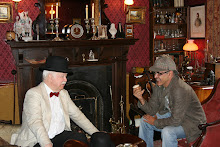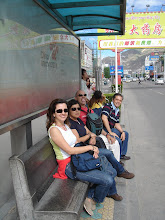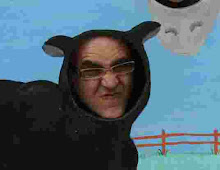Peru, again
Introduction Note: This is a history (6 episodes) of
two friends, Luis Machado and myself, that used to work together, in the same
office, in the same room, in the same field, and one day got separated by the
tricks of destiny sliding through nature with twin souls. Luis is now living in
Peru and i´m steel keeping the same office that once was our common shelter.
Another friend from that same time, Jorge Santos, who have also moved to Peru,
mixed his feet with ours in the first steps of the adventure that will be told
herein, and dragged us to that overwhelming darwinian landscape of Ballestas
(post of today) and Paracas (next post, next week). From there, from the pacific
coast, we would climb over the 4000m and arrived in Huamachuco in the top of
the Andes. For a couple of days, we stayed there sliding our eyes over that
magnificent landscape. As two Condors. And with the music that arise from our
twin souls.
Opening the Cerimony, Luis sings “his lyrics”
today. Next week will be my turn.
Ballestas Islands (Lost islands in the green of
the Pacific Ocean)
A difficult sunrise with the eyes shadowed by
the first sun lights that erase from the Peruvian coast. 24th June,
the day of St. John for Portuguese people, a day that always make me feel the
lack of my Portugal….
An excellent day to go into an adventure in the
green fields of the pacific ocean, in Ballestas islands. Stolen from a sardine
night, pork ribs and “caldo verde”, that was not over yet, we moved to Paracas
to get the first boat to the islands in the early morning. The morning fresh
air and the overwhelming landscape lead us to forget the missed sleeping hours,
injecting the energy and the dynamic to incorporate the the landscape that
would get into our souls.
A lamp marked in a consolidated sandstone,
drown by an ancient civilization, a Christ worked in rocks by the audacious Pacific
ocean, a white cover painted by the shit of all the birds that live in those
islands. A piece of the art of nature, only disturbed by the noise of the ship
motors.
The pictures talk from themselves… And that was
the beginning of one more traveling adventure of my good friend Nuno Cruz, this
time in Peru, which I followed without losing even the small part of it.
Every
conversation, every shared music were a travelling inside another travelling, a
tour around the world inside the tour around the country. A fantastic meeting
of friends. Different generations, similar tastes.
I leave you with the quartet of Liverpool (Here Comes the Sun, Octopus’s Garden),
hoping that they will guide you through the ocean towards a garden, not of
Octopouses, but of seawolves.
THE FLIGHT OF THE CONDOR - Las Ballestas from
nunocruz on
Vimeo.
Nota Introdutória: Esta é uma história (6 episódios) contada e
cantada em dueto, ao desafio como se faz na nossa terra, por dois tipos que
trabalharam juntos no mesmo gabinete, nas mesmas obras, e que as agruras do
destino haveriam de separar. Luis Machado vivendo no Peru, eu mantendo o
gabinete que em tempos albergou os sonhos de ambos. Um outro parceiro desse
tempo e desse trabalho, o Jorge Santos, também ele de vida mudada para o Peru, pôs-nos
as pernas a andar nos primeiros passos da história que aqui se conta, arrastando-nos
para esse magnifico paraíso natural que são as Ballestas (post de hoje) e
Paracas (próxima semana). Daí, do pé do mar, haveriamos de arrancar, em
trabalho, para os 4000m de altitude, no cume da cordilheira andina, cerca de
Huamachuco, pairando como dois condores sobre aquela paisagem magnifica e sob o
som da musica que brotou da alma dos dois.
Abrindo as hostilidades, hoje “canta”
o Luis, …
Em Terras Andinas – As Ballestas
(ilhas perdidas no verde do Pacifico)
Um amanhecer difícil com a vista
turvada pelos primeiros raios de sol que irradiam a costa peruana. Dia 24 de
Junho, dia de S. João, um dia que me faz sentir saudoso do meu Portugal…
Um excelente dia para me
aventurar junto com bons amigos (Nuno Cruz e Jorge Santos) no verde do Pacifico
com destino às ilhas Ballestas. Resgatados a uma noite de sardinhas, febras e
Caldo Verde, ainda por terminar lá seguimos os 3 para Paracas para embarcar no
primeiro barco da manhã.
A brisa matinal e a deslumbrante
paisagem que nos envolveu serviram para fazer esquecer as horas roubadas ao
sono e injectar uma boa dose de energia e empolgamento para aproveitar
profundamente aquelas imagens que nos veriam a entrar pela retina. Um
candelabro desenhado na areia consolidada por uma civilização antiga, um Cristo
desenhado pela audácia do mar, um manto branco pintado pelos dejectos da
passarada que por ali habita. Uma obra de arte da natureza só perturbada pelo
ruído dos motores das lanchas. As fotos falam por si.
E assim começou mais uma viagem
do meu amigo Nuno no Peru, da qual eu me esforcei para não perder pitada. Cada
conversa, cada musica partilhada, foram uma viagem dentro de outra, uma volta
ao mundo dentro de uma volta por um país. Gerações distintas, gostos comuns. Excelente
reencontro de amigos.
Deixem que o quarteto de
Liverpool (Here Comes the Sun, Octopus’s
Garden) vos guie, nas primeiras horas da manhã, mar adentro até um jardim,
não de polvos mas de lobos marinhos.
.jpg)




